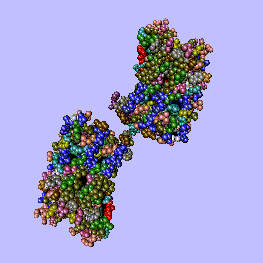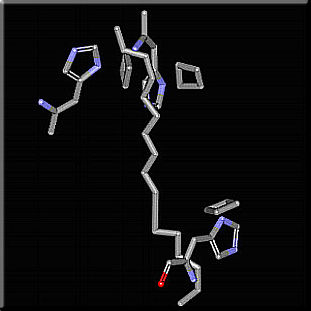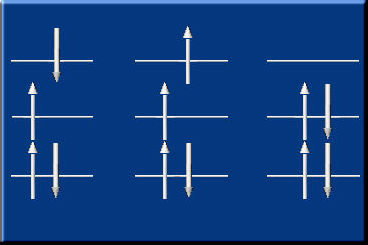|
|
La imagen del PDB en la sección de la ESTRUCTURA es realmente parte de una colección grande de conformations de esbilidad comparable. La animación demuestra una simulación de la dinámica molecular de una subunidad de una proteina collectora de energía radiante. Los acontecimientos que ocurren en un segundo de la animación suceden realmente en aproximadamente tres picosegundos. Y esa escala de tiempo no es suficientemente corta para proporcionar una vista detallada de todos los acontecimientos que suceden entre cada cambio conformational de la proteína. Estamos sobre todo interesados en la cadena de acontecimientos a partir del instante en que un fotón es absorbido hasta el instante en que llega al centro de reacción. El primer evento de esta cadena de acontecimientos es la absorción de un fotón por una molécula del pigmento, y consecuentemente uno de sus electrones es promovido de su orbital molecular del estado más bajo a uno de una energía más alta. Para que este proceso ocurra la energía del fotón absorbido debe de ser equivalente a la diferencia de energía entre dos estados quánticos de la molécula del pigmento. Este constreñimiento limita grandemente la gama de ondas que una molécula puede absorber. Proteina collectoras de energía radiante están constuídas de una manera que soluciona este problema. Las moléculas del pigmento están ligadas en apoproteinas hidrofóbicas, esto cambia las características químicas de las moléculas del pigmento a forma de que puedan absorber luz en una gama espectral más amplia permitiendo que una mayor parte del espectro electromágnetico sea utilizado productivamente[i5]. Una forma en la cual los apoproteins pueden hacer eso es cambiando la gama espectral en la cual una molécula del pigmento absorbe la luz. Consecuentemente, la misma molécula del pigmento puede absorber en regiones diversas del espectro electromágnetico dependiendo de su interacción con la proteína donde está ligada. Tal es la situación de las interacciones histidine-bacteriochlorophyll-carotenoid. 
 Tres amino acidos conservados y sus interacciones. Los varios ambientes disponibles crean diferencias en las bandas de absorbencia de las moléculas del pigmento. El grupo de moléculas que resulta no solamente absorbe sobre una gama espectral más ancha, las diferencias de la energía crean una cierta clase de mecanismo en forma de embudo para la transferencia de energía. Puesto que la energía viaja hacia áreas de un potencial más bajo, el centro de reacción está seguro de obtener toda la energía que necesita para la fotosíntesis.  This animated gif illustrates the transfer of exitation energy towards the reaction center As it has already been pointed out; the absorption of a photon raises a pigment molecule to one of its higher excited states. 
The energy of a given excited state varies according to the environment where the pigment molecule is located. The relative energy and population of a given excited state may be further affected by the dialectric constant of the surrounding molecules, their abilility to form hydrogen bonds with the pigment molecules and the coordination sphere of the metallic center as in the magnesium core of a bacteriochlorophyll ring. What do all of the above factors have in common? It is clear that they tend to change the shape of molecules, this traslates into either creation or destruction of symmetry. Everyday experience tells us that when something goes up it has to come down unless energy is continuously supplied. There are many options avialable for the decay of an excited state. We are mostly interested with the two options that become avialable when several, slightly different species are present: transfer of energy to a molecule with an excited state of lower energy and transfer of an electron to or from the other molecule. The former may result in either sensitized fluorescence or another energy transfer, the latter is a transitory ion pair, which may under certain circumstances result in permanent chemical change[t11]. Energy transfer is, most of the time the first process that occurs after light absorption by pigment molecules. A simple model for energy transfer towards the reaction center was already illustrated in the previous sections. However, even if the energy reaches the reaction center, that does not guarantee an energy usage efficiency of nearly 100%. Sometimes the reaction center will be busy and the energy will not be absorbed. A model for transfer of exitation energy among more or less identical pigment molecules can be applied to explain how the photosynthetic unit deals with this kind of situation. An explanation can be generated with a computer simulated Random Walk. The master equations are listed at the bottom of this page. For this model it is assumed that a group of funnels are organized in domains of N funnels each. Energy can be tranfered among the lowest part of the funnels within a domain, but it is assumed that energy transfers between domains is absent. The first equation is the overall description of the process. There are two parameters upon which this process depends: The probabitity that the exitation is lost on a single transfer step and the probability that the exitation scapes after reaching a reaction center. These probabilities depend on a set of physical rate constants: kh, kl, and kt. Rate of transfer between reaction centers, rate of loss, and rate of exitation trapping respectively. In order to understand this kind of equation it is useful to to make one of the variables the defining parameter. The second equation shows the diffusion-limited case. Meaning that the exitation cannot escape from the reaction center. Notice that when that is the case, the probability of trapping (ft) and hence the the efficiency of energy usage is determined by the rate of exitation transfer and the rate of exitation loss. The third equation shows the trapping-limited case. The trapping probability is then controled by the rate of exitation loss and the rate of exitation trapping. Notice that a large rate of exitation loss will result in poor efficiency. The last equation summarizes the magnitude of energy loss. If the reaction centers were deactivated, then the quantity (ft) would be zero and all the energy would be lost. Computer simulations using the above described algorithms show that the quantum efficiency of photosynthetic units is nearly perfect.  |


